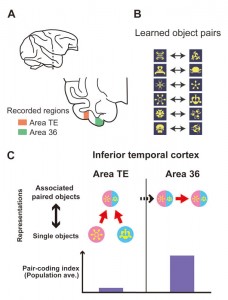New organizational principle of brain’s internal representation of external world Precursor-code creation and proliferation in neuronal representation

We recognize the external world through the neuronal representations in our brain. How the neuronal representations are organized and used has been most intensively investigated in terms of visual features of objects. Recordings of single-neuron activities in monkeys have revealed that neuronal representations of objects are sequentially elaborated through the cortical hierarchy in the primate occipito-temporal lobe. The conventional view posits that representations of a “novel” feature that constitutes a given object would emerge and become prevalent in one of the areas in the cortical hierarchy.

© Yasushi Miyashita,
A) (Top)Side view of the macaque brain. Right, anterior. (Bottom) Coronal section at the dotted line. Left, lateral. B) Learned pairs of objects in a pair-association memory task. C) Proposed model for the representation of object association in the inferior temporal cortex.
The representation of object association has been thought to be constructed in the higher-order area 36, because the population value of the associative representation is higher in that area than in the lower-order area TE (purple histograms). By investigating neuronal circuits in each of these areas, the researchers found that the “precursor” representation of object association is created in area TE first, and then it is transferred to area 36, where the representation “proliferates” and becomes prevalent.
In this study, Professor Yasushi Miyashita, Project Lecturer Toshiyuki Hirabayashi and their colleagues at the University of Tokyo Graduate School of Medicine’s Department of Physiology tested another possibility, the precursor-code creation and subsequent proliferation hypothesis: when a novel feature representation becomes prevalent in a given cortical area, a small number of “precursor-codes” are created as a result of computations in a microcircuit in a hierarchically prior cortical area. Then the precursor-code is transferred to the next area, where the representation “proliferates”, and becomes prevalent.
To test this precursor-code creation and subsequent proliferation hypothesis, it is necessary to identify the neuronal process that generates such precursor-codes. However, this was not possible with the conventional experimental approach of single-neuron recording, because analysis of neuronal circuit operation is required, which has long been a critical and challenging issue in brain science. In the present study, the researchers conducted simultaneous recordings from multiple neurons in each of two successive areas, TE and 36, of the macaque inferior temporal cortex. They examined the neuronal microcircuit that generates the representations of object-object association, and demonstrated that their hypothesis holds true.
The present findings support the precursor-code creation and subsequent proliferation hypothesis as a theory of the organizational principle of neuronal representations. This theory is distinct from the conventional view in the sense that computation across different levels of the cortical hierarchy is essential for generating a feature representation. Thus, it may facilitate the development of a computer database with a similar hierarchical structure. The researchers’ previous studies have demonstrated that the neuronal representation in the temporal cortex not only mediates the recognition of the external world but also serves as the database of internally accumulated long-term memory. Because controlling only a small number of precursor-codes would exert a substantial effect on the representation in the higher-order area, it is expected that these findings might lead to the improvement of medical care for people with diseases related to cognitive and/or mnemonic processes mediated by internal cortical representations.
Press release [pdf] (Japanese)
Paper
Toshiyuki Hirabayashi, Daigo Takeuchi, Keita Tamura, Yasushi Miyashita,
“Microcircuits for hierarchical elaboration of object coding across primate temporal areas”,
Science Vol.341, (2013): 191-195, doi: 10.1126/science.1236927.
Article link
Links
Department of Physiology Laboratory of Integrative Physiology, Graduate School of Medicine






